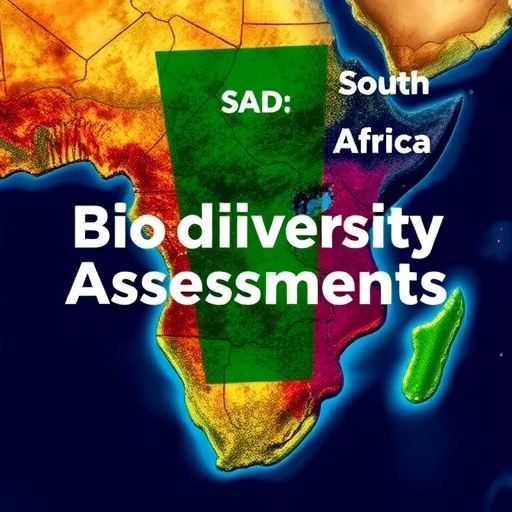In a groundbreaking study published in Ambio, researchers have delved into the intricate relationships between national biodiversity and ecosystem assessments and their influence on conservation outcomes. The paper, authored by an esteemed team including da Silva, Seymour, and Harris, provides a comprehensive analysis of the South African experience in implementing these assessments. This research proves pivotal for countries grappling with biodiversity loss and seeks to offer vital insights that can be harnessed globally.
The importance of assessing biodiversity extends far beyond mere data collection. Biodiversity assessments serve as a critical framework for understanding the dynamics of ecosystems, identifying species at risk, and assessing the health of environments. By meticulously evaluating these dimensions, policymakers can make informed decisions that enhance conservation practices. The South African model illustrates how integrated assessments can lead to actionable strategies that resonate with diverse stakeholders, from local communities to governmental bodies.
Central to this research is the methodology adopted by the South African government, which emphasizes the inclusion of multi-disciplinary expertise. Traditionally, assessments may have focused solely on biological data, but this study highlights the necessity of incorporating social sciences. Engaging with sociologists, economists, and local communities has proven essential in creating a holistic approach to biodiversity. This inclusive strategy not only fosters collaborative conservation efforts but also empowers communities, making them active participants in safeguarding their natural heritage.
Moreover, the findings suggest that transparency in the assessment process is crucial. The study indicates that when communities are informed about the methodologies and objectives of biodiversity assessments, they are more likely to trust and support conservation measures. This trust translates into greater public engagement and enhanced conservation outcomes. The paper emphasizes that effective communication about scientific findings can bridge gaps between researchers and the communities they aim to protect.
The authors further discuss the implications of their findings for global biodiversity initiatives. In an era of alarming biodiversity decline, characterized by habitat destruction, climate change, and pollution, the lessons learned from South Africa are not just regionally relevant but possess universal significance. Nations struggling with similar environmental crises can derive valuable insights from South Africa’s experience, tailoring assessment frameworks that suit their unique ecological contexts.
Another pivotal element of the research is the role of technology in biodiversity assessments. The integration of innovative tools such as satellite imagery, GIS mapping, and data analytics has revolutionized how scientists gather and interpret ecological data. These advanced technologies allow for real-time monitoring of ecosystems, offering unprecedented insights into biodiversity trends. The authors argue that embracing this technological revolution is fundamental for the future of conservation, enabling more accurate and timely interventions.
With the momentum of climate action intensifying, the contributions of biodiversity assessments are more critical than ever. This research highlights how fluctuations in biodiversity directly influence ecosystem services that humans rely on, such as clean air, water, and food sources. Understanding the nexus between biodiversity and human well-being becomes imperative as we navigate the impacts of global warming and other environmental threats.
Furthermore, the authors pointed out that national biodiversity strategies must align with broader environmental policies to maximize effectiveness. This requires an interdisciplinary approach, where conservation efforts intersect with economic, health, and urban planning policies. Without this interconnectedness, biodiversity assessments risk becoming siloed, limiting their potential impact on conservation success.
The research also advocates for a paradigm shift towards adaptive management strategies. Traditional static conservation measures often fail to account for the rapidly changing environmental landscape. The paper suggests that incorporating adaptive management practices can allow for more resilient ecosystems that can better withstand climatic fluctuations and anthropogenic pressures.
Amid this emphasis on strategic frameworks, the authors recognized the challenges faced by policymakers and practitioners in implementing biodiversity assessments. They highlighted institutional constraints, lack of funding, and insufficient collaboration as significant hurdles. Addressing these challenges requires concerted efforts from both national governments and international organizations to create enabling environments conducive to effective biodiversity conservation.
As the study draws to a close, the authors express hope that the insights provided through their research will not only stimulate further academic discussion but also translate into tangible action on the ground. By learning from South Africa’s experience, other nations can pave the way for meaningful conservation initiatives that protect biodiversity for future generations.
In light of the urgent need for action to counter biodiversity loss, the implications of this research cannot be overstated. It serves as a clarion call for the integration of science and policymaking, urging a synchronization between ecological assessments and sustainable development practices. With a unified approach, the global community can aspire to achieve viable solutions for some of the most pressing environmental challenges of our time.
In summary, this pioneering research offers invaluable lessons that illuminate the pathways towards effective conservation. By sharing their findings through this prominent publication, the authors hope to inspire a broader dialogue about the essential role of biodiversity assessments in fostering sustainable futures. The call to action is clear: to protect our planet’s rich tapestry of life, we must commit ourselves to integrating sound scientific practices into the policies that shape our world.
As the world grapples with the ecological crises ahead, the findings from this study stand as a testament to the power of collaboration, technology, and innovative approaches to secure a sustainable future for all living organisms.
Subject of Research: Biodiversity and ecosystem assessments for conservation impact in South Africa.
Article Title: National biodiversity and ecosystem assessments for conservation impact: Uptake and lessons learnt from the South African experience.
Article References:
da Silva, J.M., Seymour, C.L., Harris, L.R. et al. National biodiversity and ecosystem assessments for conservation impact: Uptake and lessons learnt from the South African experience. Ambio (2025). https://doi.org/10.1007/s13280-025-02285-8
Image Credits: AI Generated
DOI:
Keywords: biodiversity assessment, conservation strategy, South Africa, ecosystem services, adaptive management, interdisciplinary approach, technology in conservation, community engagement.




